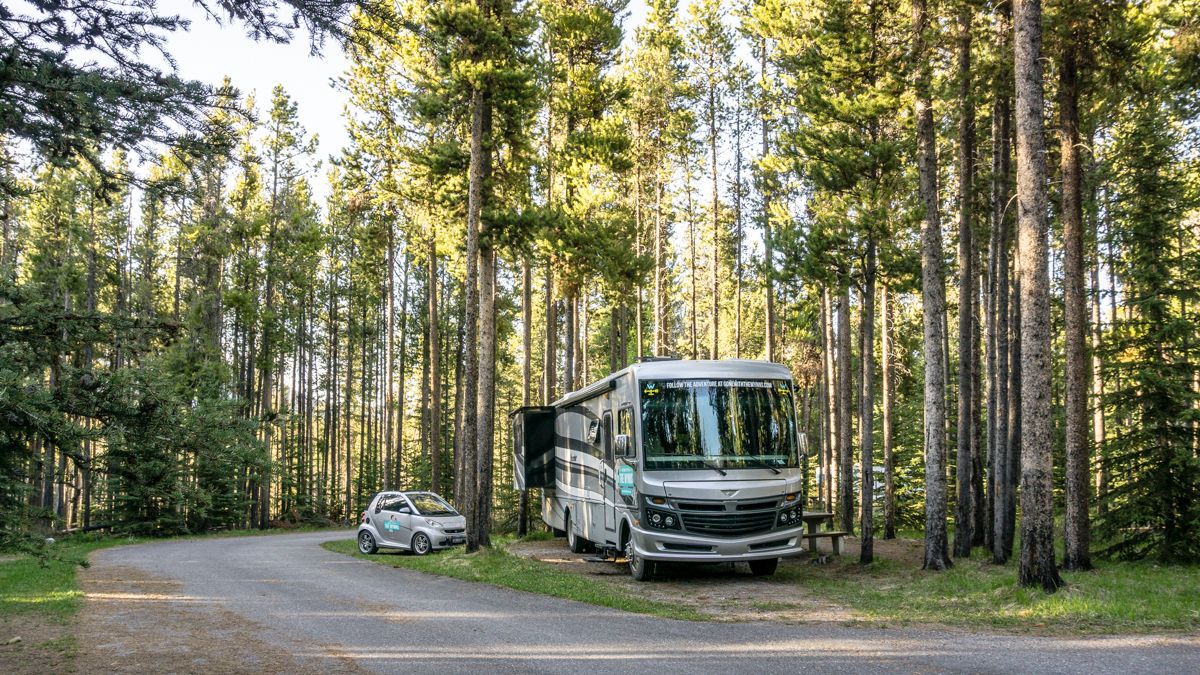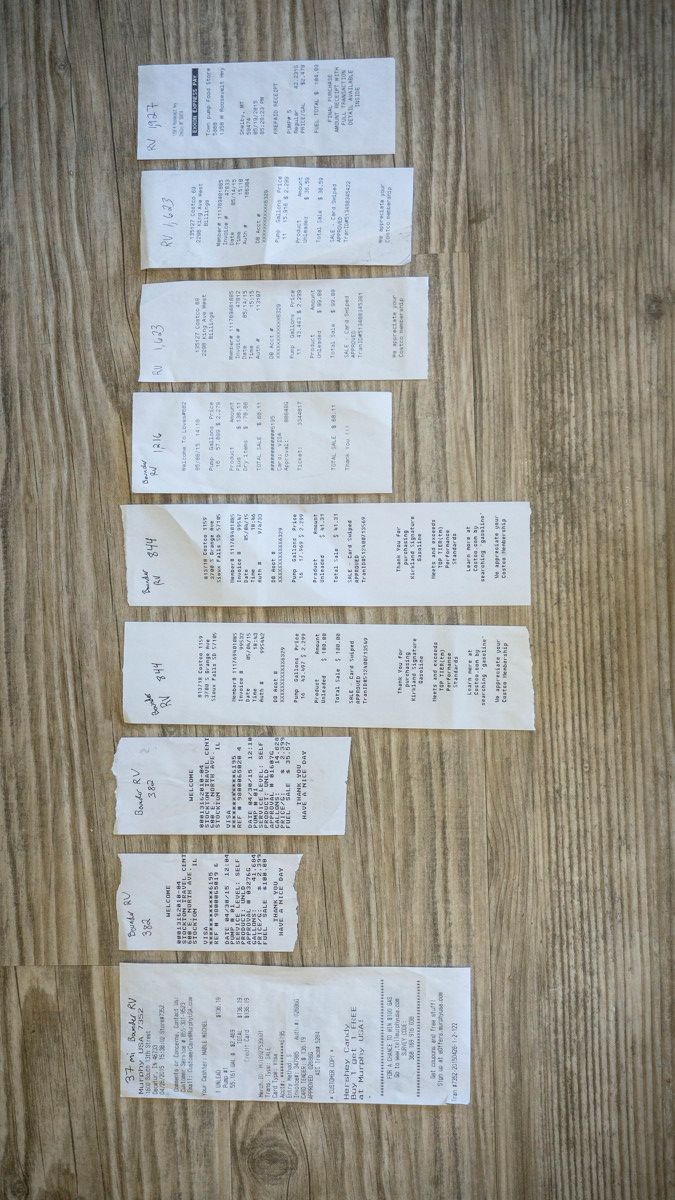Our Gas RV MPG – Fleetwood Bounder with Ford V10

If you’ve found this article while looking for a fuel efficient RV or motorhome your search may sadly end here. I hate to say it but the RV industry hasn’t been forced by the consumer, or the government, to design class A motorhomes that get a Miles Per Gallon that one can be proud to share with their friends. Trust me, when we started our search for an RV we spent countless hours online looking up Most Fuel Efficient RV, Best RV MPG, Green RV, Hybrid RV, and so on… We are really hoping there’s a change for the better in the near future.

At this point we’ve had three different Class A Diesel RVs: 2 Front Engine Diesels (a Damon Avanti and a Monaco Vesta) and one rear engine diesel (a Fleetwood Excursion). Although I didn’t track and share the MPG of our Avanti it was the best performer due to the smaller 31’ size and lighter weight. Our Vesta came in a very close second averaging a fuel economy in the almost 11ish MPG area. Our Excursion came in third but considering it wasn’t designed for fuel efficiency like our Vesta, I was pleased when we tracked the fuel economy in the 9.5 MPG range.
Now enter our new home on wheels: A Ford V10 powered Gas RV, in fact it’s our first class A gas RV ever! She’s a 2016 Fleetwood Bounder 33C. Without further ado, here is the MPG of our new motorhome.

Indiana to Montana
04/28/2015 – 05/19/2015
It was warm enough we had to run the dash AC a bit, but not too much. We climbed several hills en-route and we battled some strong crosswinds through most of the Midwest. I did run the generator for a few hours during this time (I had to test it to make sure it worked) but I have not notated the hours or adjusted for the fuel used, I’m assuming it’s only a teeny fraction of a gallon difference for the overall MPG.
- Gallons: 331.82
- Miles: 1,890
- Fuel Cost: $784.34
- Avg Price per Gallon (regular unleaded): $2.36
- Avg Motorhome Fuel Economy: 6.83 MPG

Alberta to Alaska
05/21/2015 – 06/12/2015
Our dash AC stopped working so we didn’t use it all during this trip. We didn’t pass any major mountains however we did climb many hills on this route with lots of long 6% grades. Wind was average but not anything to complain about. We did not run the generator during this part of the trip (thanks to our solar and lithium technology upgrades).
- Gallons: 280.51 (Liters: 1,061.85)
- Miles: 1,537 (2,473.562 kilometers)
- Fuel Cost: $953.91 ($1,239.61 CAD)
- Avg Price per Gallon (regular unleaded): $3.40 USD
- Avg Gas RV Fuel Economy: 6.44 MPG (2.74 KmPL)
Our Alaska Road Trip
06/14/2015 – 09/04/15
This is our entire RV Road Trip in Alaska! From my first fill-up in Tok (I’m putting my Chicken, AK top off in the Canada numbers) to my last fill-up just before crossing the Canadian border. I’m trying to make sense of these numbers and I have no idea why our Gas RV MPG was so low in Alaska. Maybe it was more hilly and mountainous than our previous routes? Maybe it’s the dusty, rough roads we traveled at such low speeds? We ran the dash A/C here and there once it was fixed and we ran the generator a bit, but not enough to impact the numbers too much. I’ve triple checked my receipts and I’m not missing anything so sadly, I guess these are our Alaskan Fuel Economy Numbers.
- Gallons: 449.47
- Miles: 2,474
- Fuel Cost: $1,552.30
- Avg Price per Gallon (regular unleaded): $3.45
- Avg RV Fuel Economy: 6.13 MPG
Canada Route to the Lower 48
09/05/2015 – 09/27/2015
Sadly, we rushed through this portion of trip heading south from our Alaska Adventures. My first Canadian fill-up was in Whitehorse, YT and our last was just south of the Canadian Border in Lacey, WA (I didn’t finish with a fill-up in BC because fuel is so darn expensive in Canada). The roads were in good condition, we met very little traffic or construction, it’s probably the most smooth sailing we’ve experienced on this trip. There are some hills but nothing that stood out to me as a big mountain. I don’t think we ran the generator this entire route so we can throw that wild card out the window. How did I end up with such poor MPG? Good news is the price per gallon is a little bit lower than Alaska Fuel Prices due to the US dollar being about 30% stronger than the Canadian Dollar.
- Gallons: 320.47 (Liters: 1,213.111)
- Miles: 1,817 (Kilometers: 2,924.178)
- Fuel Cost: $1,017.85 USD ($1,323.89 CAD)
- Avg Price per Gallon (regular unleaded): $3.18 USD
- Avg RV Fuel Economy: 6.67 MPG (2.84 KmPL)
If you’ve guessed we’re not too happy with these numbers, trust me, you’ve guessed right! It’s a real bummer that gas RVs don’t get near the fuel economy as a diesel motorhome…but they’re a lot less expensive so most people say it comes out in the wash.
Here’s my extremely important RV MPG disclaimer bullet points that greatly affect our overall motorhome fuel economy, small changes will most likely make your MPG numbers different:
- This RV is brand new so the engine isn’t broken in yet, over time the MPGs will likely increase (a fraction)
- When carrying water, fuel and propane we are sitting right at our 22,000lb GVWR
- We are flat towing a 2000lb Convertible Smart Car which brings us approx. 2000lbs shy of our 26,000lb GCWR, so we’re nearly maxed out on all our weight ratings
- We typically drive around 55 Miles Per Hour and rarely go faster than 60 MPH
I’m using an app called Fuelio to track my fuel numbers and provide my RV MPG reports.




